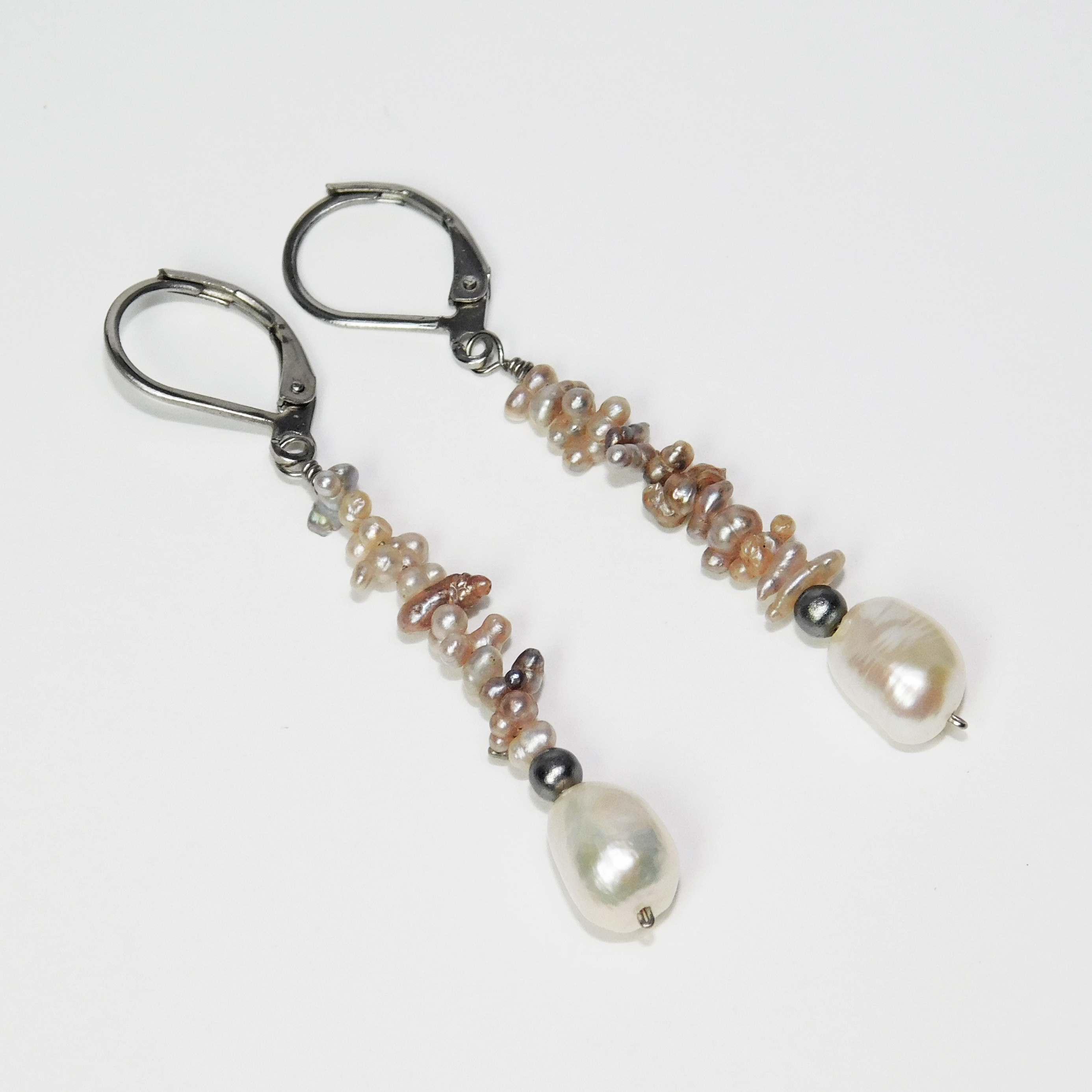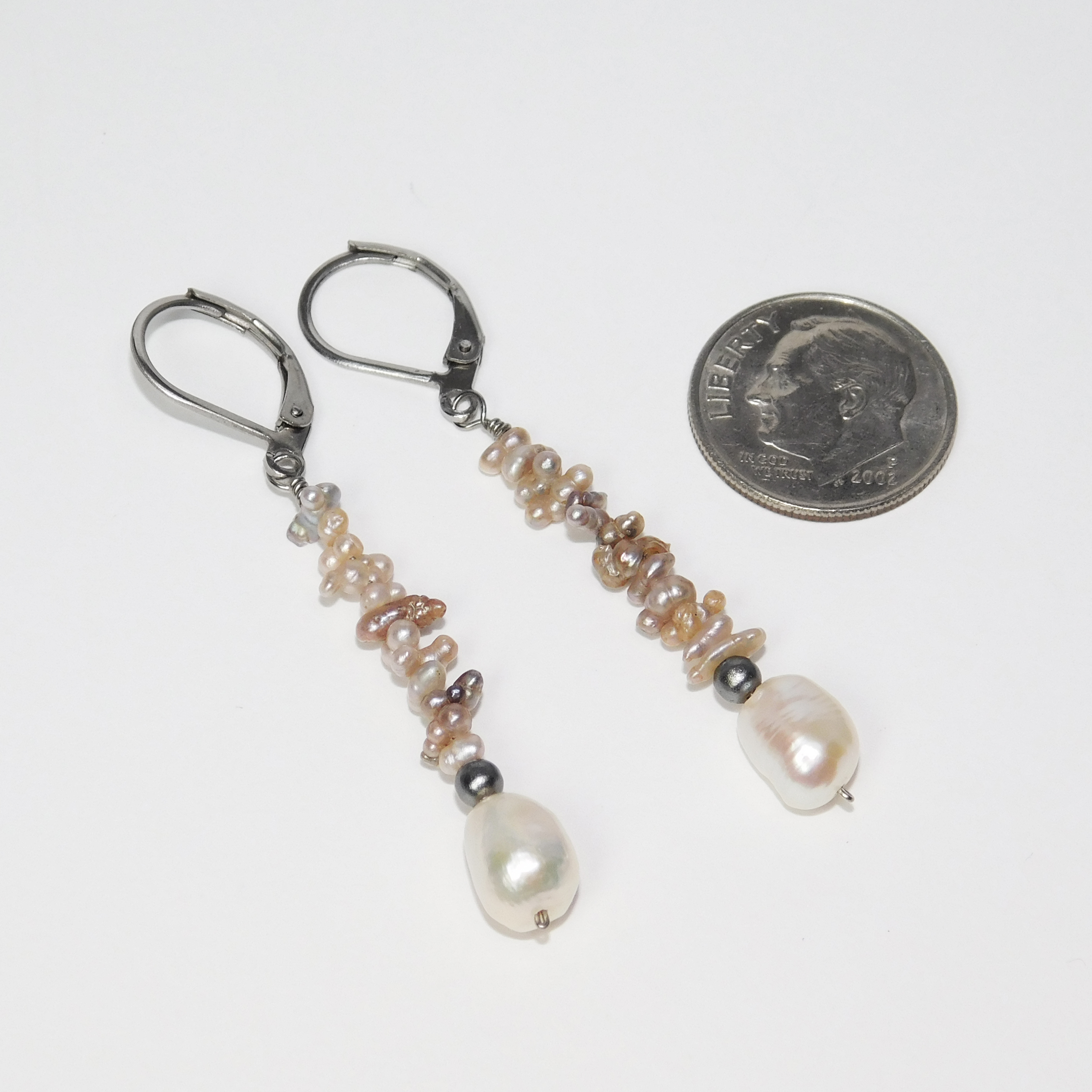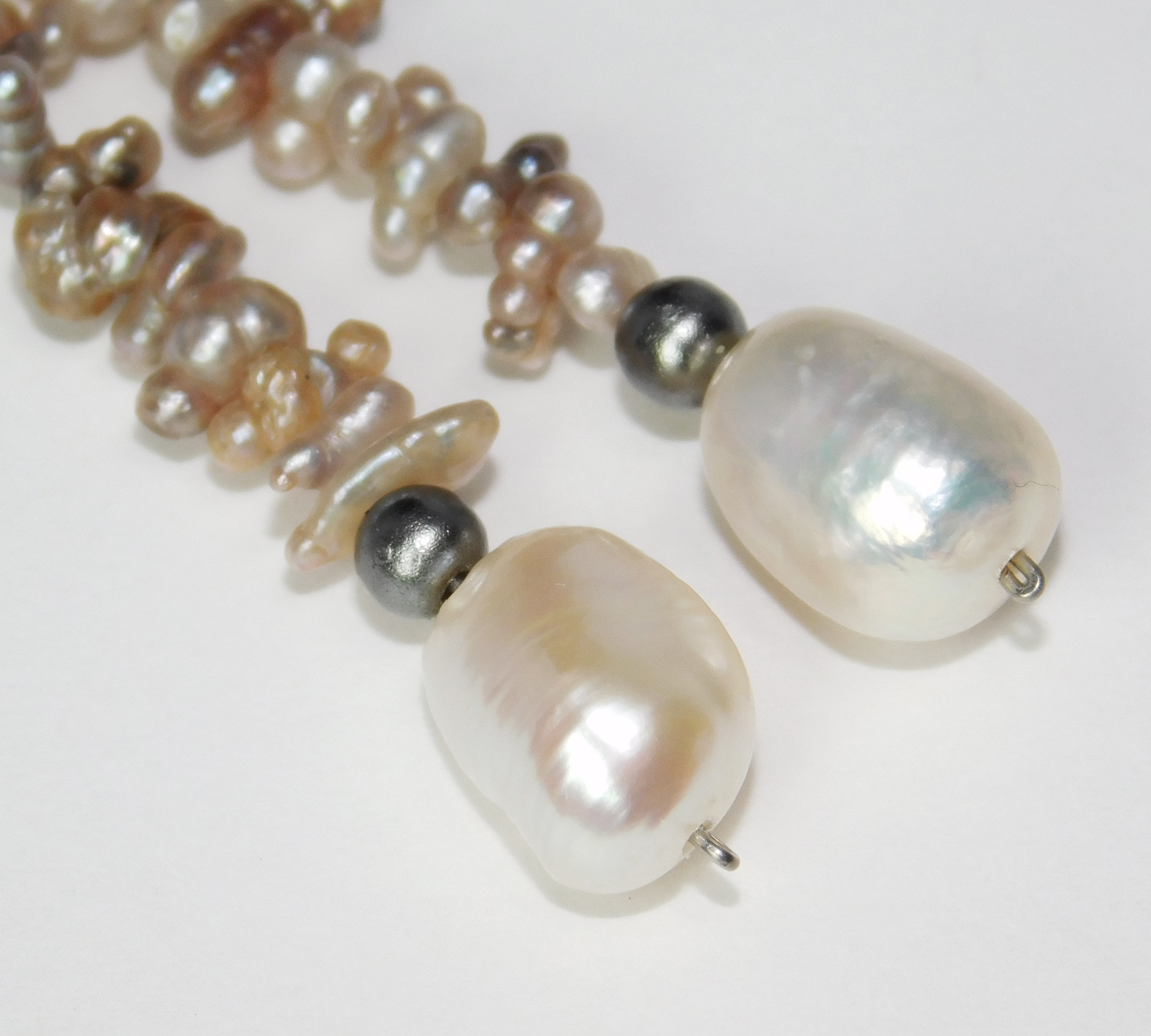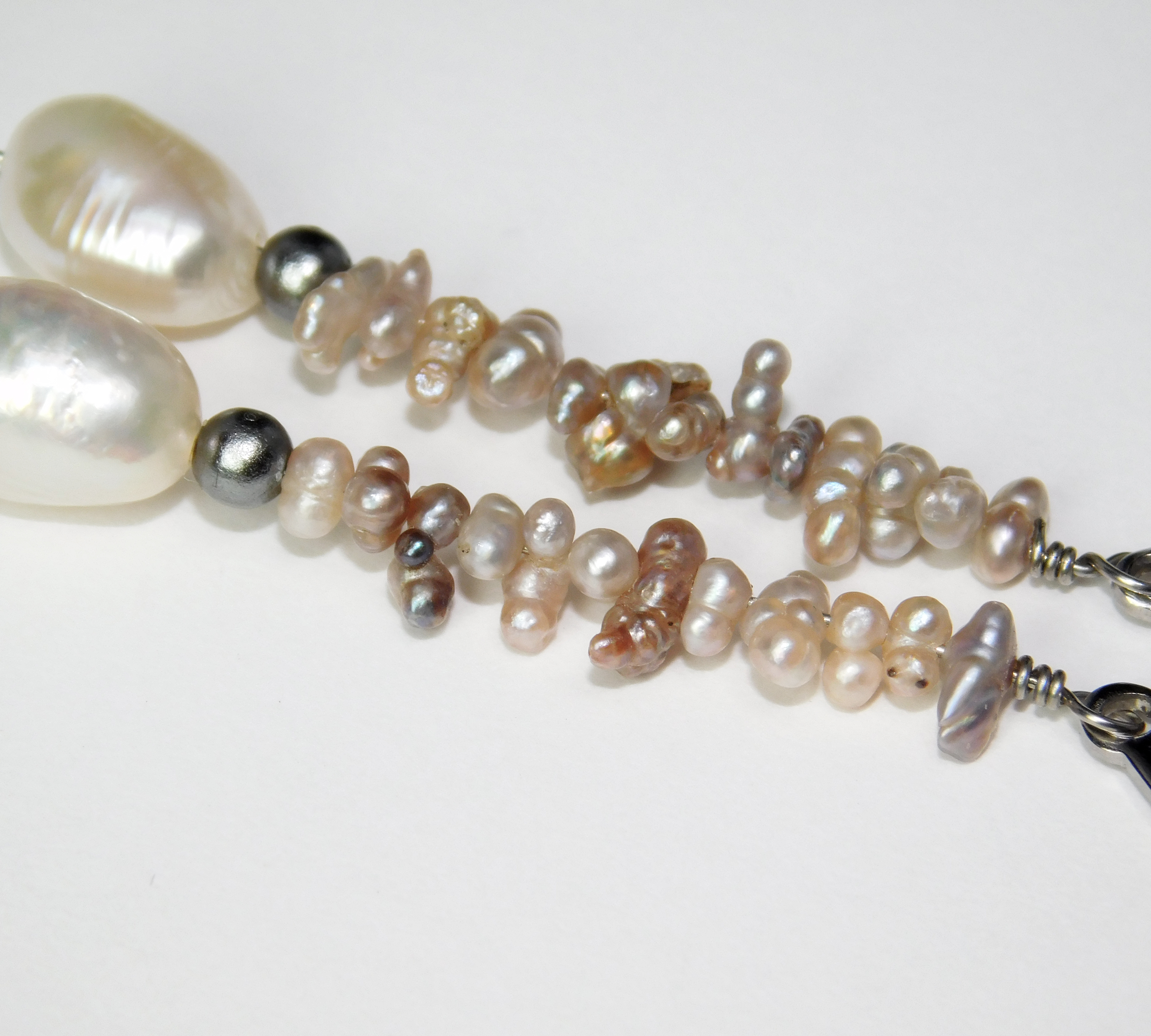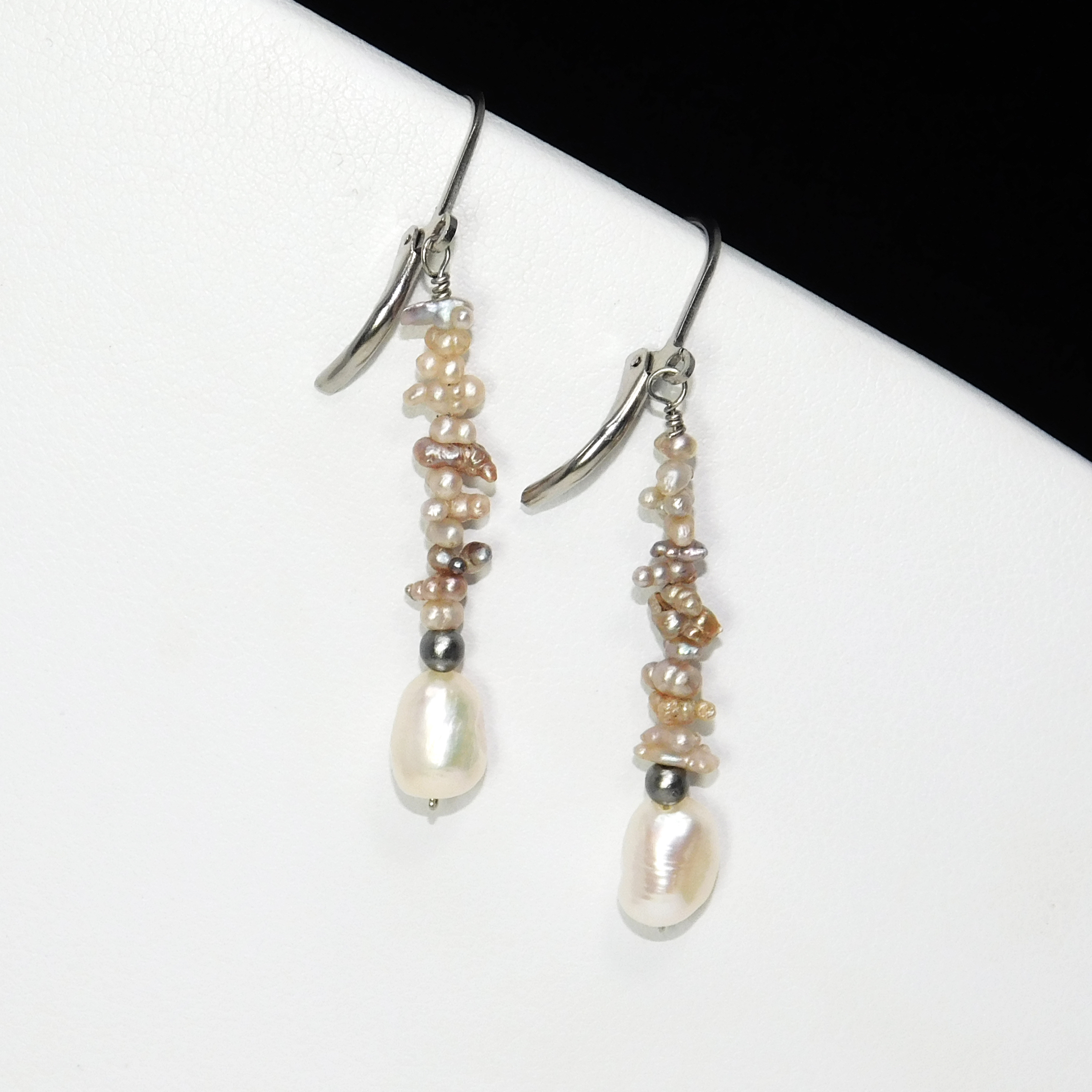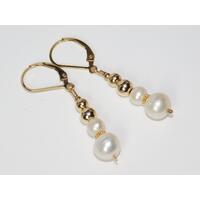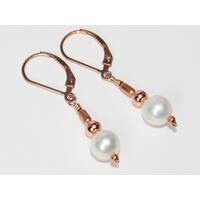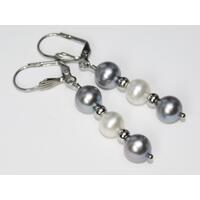About this Product
These earrings feature two kinds of rare, natural, all nacre pearls: Basra Arabian Gulf and Sea of Cortez seed pearls. They are finished with sterling silver wire and lever backs. The Cortez Keshi seed pearls are free-form, non-nucleated pearls, often the by-product of pearl cultivation and, as a result, they are solid nacre and can have incredible luster.
The Basra pearls measure 9 x 6.5 mm, and the earrings measure 2 1/8" in total length. Both types of these pearls are extremely rare.
US dime (18 mm) for scale. Pearl info below.
Pearls are one of the most beloved gems, used for millennia in jewelry and decoration, and are the only gems grown inside a living organism. The first recorded mention of pearls is 7,500 years old. They are one of a few organic gemstones, including ivory, amber, and coral.
Pearls are one of the birthstones of June, along with color-changing alexandrite, and moonstone. It is also the 3rd and 30th wedding anniversary gem.
Basra pearls are rare, natural, uncultured pearls from the Arabian Gulf, prized for millennia as the standard of natural pearls. While the term encompasses natural pearls from the Arabian Gulf, "Basra" refers to the city which was a trading hub for the pearls in the past. They are grown by the Pinctada radiata oyster, yet overfishing and pollution due to the region's oil production has only increased their rarity. While a small amount is still harvested, the majority of Arabian Gulf pearls on the market are vintage.
The combination of fresh and saltwater, warm and shallow waters, and nutrient levels of the Arabian Gulf directly affects the colors and iridescent luster of Basra pearls. The crystalline layers of nacre scatters light creating a silky luster in white, cream, silver, pink, and golden colors. Most are baroque in shape, making round Basra pearls more rare in comparison. They are also lighter in weight than other natural pearl counterparts.
The nation of Bahrain, known as The Island of Pearls, thrived as a pearling center for over 4,000 years, and it was even mentioned in the writings of Pliny the Elder, considered by some to be the first gemologist. Pearl divers in the Gulf used to go out on boats for months at a time, diving for pearls while holding their breath, while their families would sing and pray for their safe return in the dangerous industry. 70-80% of all pearls originated from the gulf area until the 1950s, and represented up to 95% of local incomes and 75% of the Gulf's total exports during the peak. The Bahrain pearl beds were designated a World Heritage Site in 2012.
The invention of cultured pearls, world wars, and oil discovery crashed the natural pearl market in the mid-20th century, yet the prestige of natural pearls remains uncontested. Natural pearls make up only 2-5% of pearls available on the market today, and Basra pearls only claim a fraction of that amount. Only about one in 10,000 wild oysters will yield a natural pearl, and not all of those pearls are gem quality.
Basra pearls have been a feature in crown jewels and jewelry of the ultra-wealthy for many centuries, adorning royalty, clothing, palaces, thrones, screens, pillars, doorways, and even a carpet called the Baroda Pearl Canopy. Notable examples of Basra pearls include the jewelry of Empress Eugenie, Queens Elizabeth I and II, Nizams and Maharajas of India, and countless others. The Maharaja of Baroda, Khande Rao Gaekwar, commissioned an incredible seven-strand necklace worn for generations, of which only two strands survived to be sold by Christie's in 2007 for $7.1 million USD.
A seed pearl is a tiny, natural, solid nacre pearl often created unintentionally during pearl farming while cultivating larger pearls, in this case at the Sea of Cortez Pearl Farm at Bacochibampo Bay in Mexico. Sea of Cortez pearls are the rarest cultured pearls in the world and come in incredible colors. The cultivation process takes at least 4 years, and less than 4,000 pearls are harvested yearly. The Gulf of California (also known as the Sea of Cortez) is home to a vast array of marine life, including the Humboldt squid, blue whales, dolphins, sea lions, and pearl-producing oysters. Sea of Cortez pearls come from the Panamic Black-Lipped oyster (Pinctada mazatlanica) and the more colorful Rainbow-Lipped oyster (Pteria sterna), both native to the area. In the 16th century, Spanish expeditions to the area sparked the world's obsession with these incredible pearls, commanding a price double that of all other exports in the New World combined, including gold, silver, and spices. The gulf became the pearl capital of the world and its pearls were called "Queen of Gems and Gem of Queens" and adorned the likes of Queen Elizabeth I, Catherine the Great, Marie Antoinette, and the Imperial State Crown of Queen Elizabeth II. They were nearly fished to extinction until a ban saved them in 1939, with cultivation beginning in the 1990s.
JReneau - Pearl Girl
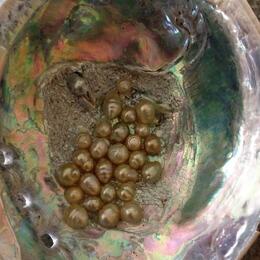
Meet the Maker
I am the mother of three daughters. I also have four grandchildren, 2 boys and 2 girls. We all live here & see each other nearly everyday. I am very blessed.
I have been an artist all my life. I have painted in watercolor for over 40 yrs. I have been a paper maker for 16 yrs. Look in my shop sections for Fine Art and Handmade Paper. I have been a jewelry artist for 12 yrs.
I take my work seriously. I use the best materials and am proud of my creations. I’m in love with color change gemstones and feature them as often as I can. I also love American Gemstones and do some rock hounding myself.
If you are looking for a particular gem or mineral, contact me. I have lots of goodies not show in my shop yet. Blessings, Jane

How it’s Made
Basra and Sea of Cortez pearls on sterling silver wire and lever backs.
Shop Policies
Returned items must be in the original condition for refund. We urge you to insure the package as we are not responsible for loss or damage. Please notify us of your intent to return the item prior to shipping.
We accept returns and cancellations
- Contact me within: 3 days of delivery
- Ship items back within: 7 days of delivery
- Request a cancellation: as soon as possible, before the order has shipped.
- Buyers are responsible for return shipping costs and insurance. If the item is not returned in its original condition, the buyer is responsible for any loss in value.
